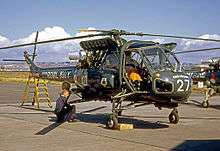HMS Ashanti (F117)
.png) | |
| History | |
|---|---|
| Name: | HMS Ashanti |
| Builder: | Yarrow Shipbuilders |
| Laid down: | 15 January 1958 |
| Launched: | 9 March 1959 |
| Commissioned: | 23 November 1961 |
| Reclassified: | Harbour Training Ship 1981 |
| Homeport: | Devonport |
| Identification: | Pennant number F117 |
| Motto: | Kum apim, apim beba':'Kill a thousand, a thousand will come |
| Fate: | Sunk as target 1988 |
| Badge: | On a Field barry wavy of six Blue and White a porcupine Gold. |
| General characteristics | |
| Class and type: | Tribal-class frigate |
| Service record | |
| Operations: | |
| Awards: | 1967: General Service Medal, South Arabian Clasp |
HMS Ashanti was a Tribal-class frigate of the Royal Navy. She was named after the Ashanti people, an ethnic group located in Ghana. The frigate was sunk as a target in 1988.
Ashanti was built by Yarrow, of Scotstoun, at a cost of £5,315,000 and was the first commissioned Royal Navy warship to be equipped with combined steam and gas (COSAG) engines.[1] She was launched on 9 March 1959 and commissioned on 23 November 1961.[2]
Operational Service
In 1962 malicious damage was reported aboard Ashanti.[3]
Ashanti deployed to the Caribbean for trials in 1962. There, in early October, the ship suffered a failure in her COSAG engines, forcing the frigate's return to Britain.[4] Subsequent tests discovered that the COSAG's machinery was defective, which caused blade fracturing in the gas turbine.[5] Hull strengthening also found to be required [3]

Ashanti was also used to trial the Westland Wasp helicopter, prior to its introduction to active service in 1964. The frigate conducted operations in the Persian Gulf and Arabian Sea for 10 months in 1963.[6] In May 1965, Ashanti suffered minor damage in a collision with the Russian cargo ship Farab in the port of Mombassa, Kenya.[7]
In 1966/67 Ashanti was deployed on the Beira Patrol. During that time she also spent a month in Aden having a gas turbine refit whilst some of the crew were seconded to the army as Britain withdrew from Aden. Given the Six-Day War, the Suez Canal being blocked, indecisiveness about whether to clear mines from the Gulf of Aqaba Ashanti headed home via the Cape of Good Hope, stopping off at Simon's Town.
In 1969 Ashanti embarked a Royal Marines Commando detachment at Bermuda during a Black Power Conference.[3]
In 1970, Ashanti deployed on Beira Patrol, which was designed to prevent oil reaching landlocked Rhodesia via the Portuguese colony of Mozambique. The following year Ashanti was present at the Royal Navy's withdrawal from Malta. In 1974, while returning to Britain from the Caribbean, Ashanti suffered two fatalities when a large wave struck the frigate. The ship was just four hours out of Bermuda on her way back to the UK when hit by the wave. One was lost at sea, while the other suffered injuries and died aboard the frigate. The ship returned to Bermuda to disembark the body, and for repairs to the upper deck structure. Premature reports by Bermudian radio stations sent invalid signals to UK and it was reported on national TV news channels that Ashanti had been sunk and lost at sea.
Three sailors died in 1977 from carbon monoxide poisoning after a fire broke out in a boiler room.[8]
Ashanti was returned to service in 1978 following a repair and refit, and finally placed in reserve and became a Harbour Training Ship. She was sunk as a target in 1988 by the submarines Sceptre and Spartan.
Commanding officers
| From | To | Captain |
|---|---|---|
| 1965 | 1967 | Commander R S McCrum RN |
| 1967 | 1970 | Commander R Compton-Hall RN |
| 1970 | 1972 | Captain Parker RN |
| 1972 | 1974 | Commander RN Blair RN |
| 1976 | 1978 | Commander Rhodes (Dusty) |
| 1978 | 1979 | Commander J J Blackham RN |
References
- ↑ "Second £7M. Assault Ship For The Navy". The Times (55326): Col A, p. 5. 27 February 1962.
- ↑ Gardiner, Robert & Chesneau, Roger (1995), p. 518.
- 1 2 3 Mason, Geoffrey B. (2007). "Chronology, Part 3 - 1961-70". naval-history.net. Retrieved 9 June 2015.
- ↑ "£5M. Frigate Breaks Down On Trials". The Times (55513): Col E, p. 4. 4 October 1962.
- ↑ "Warship's Dual Propulsion Units Faulty". The Times (55598): Col F, p. 4. 14 January 1963.
- ↑ "News in Brief". The Times (55884): Col E, p. 5. 14 December 1963.
- ↑ "News in Brief". The Times (56318): Col A, p 12. 11 May 1965.
- ↑ "Unscrewing of nut led to fatal fire in warship". The Times (59960): Col C, p. 5. 24 March 1977.
Publications
- Colledge, J. J.; Warlow, Ben (2006) [1969]. Ships of the Royal Navy: The Complete Record of all Fighting Ships of the Royal Navy (Rev. ed.). London: Chatham Publishing. ISBN 978-1-86176-281-8. OCLC 67375475.
- Gardiner, Robert; Chesneau, Roger, eds. (1995). Conway's All The World's Fighting Ships, 1947-1995. London: Conway Maritime Press. ISBN 978-0-8517-7605-7.
- Marriott, Leo (1983). Royal Navy Frigates 1945-1983. Ian Allen Ltd. ISBN 07110 1322 5.